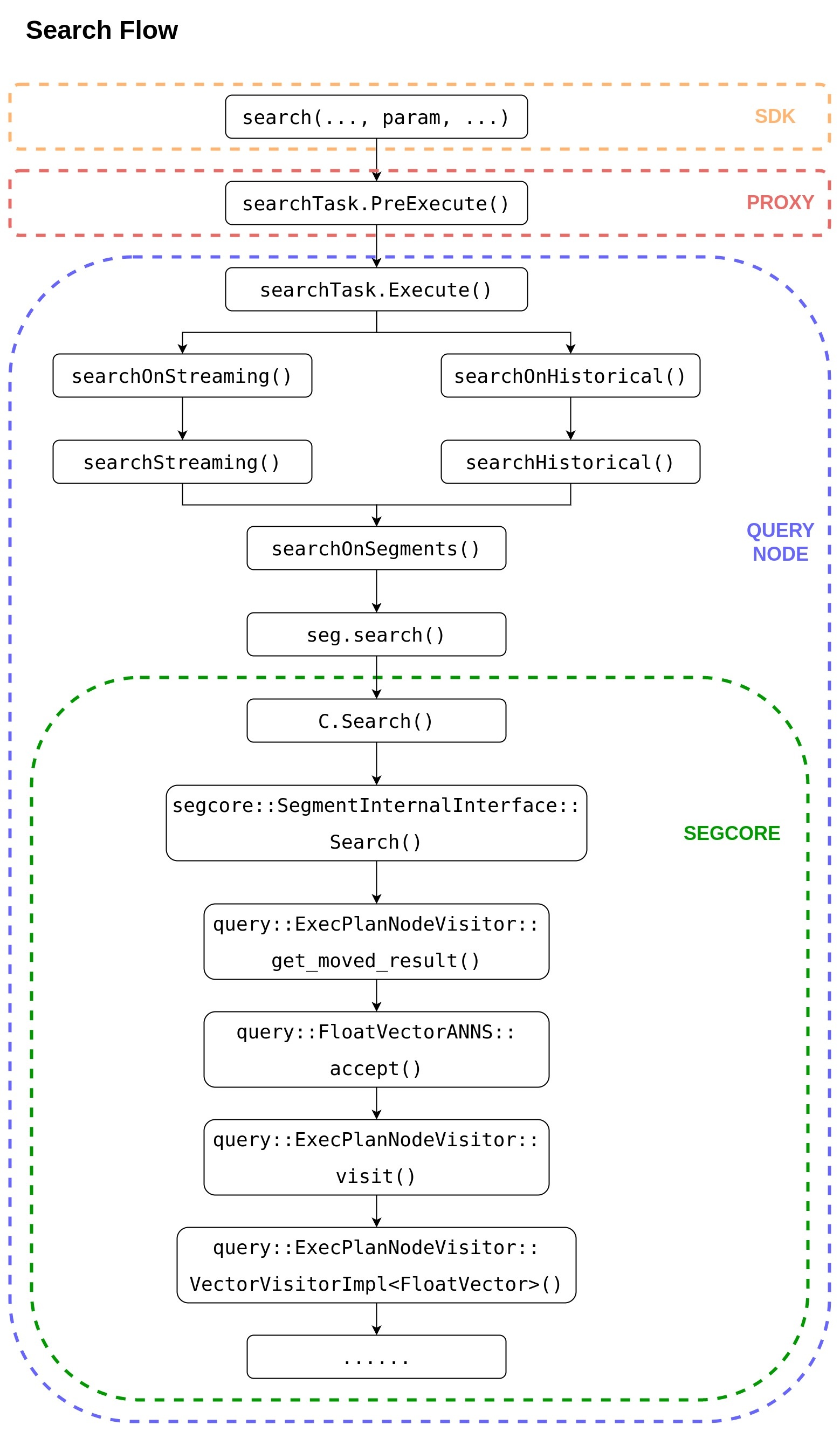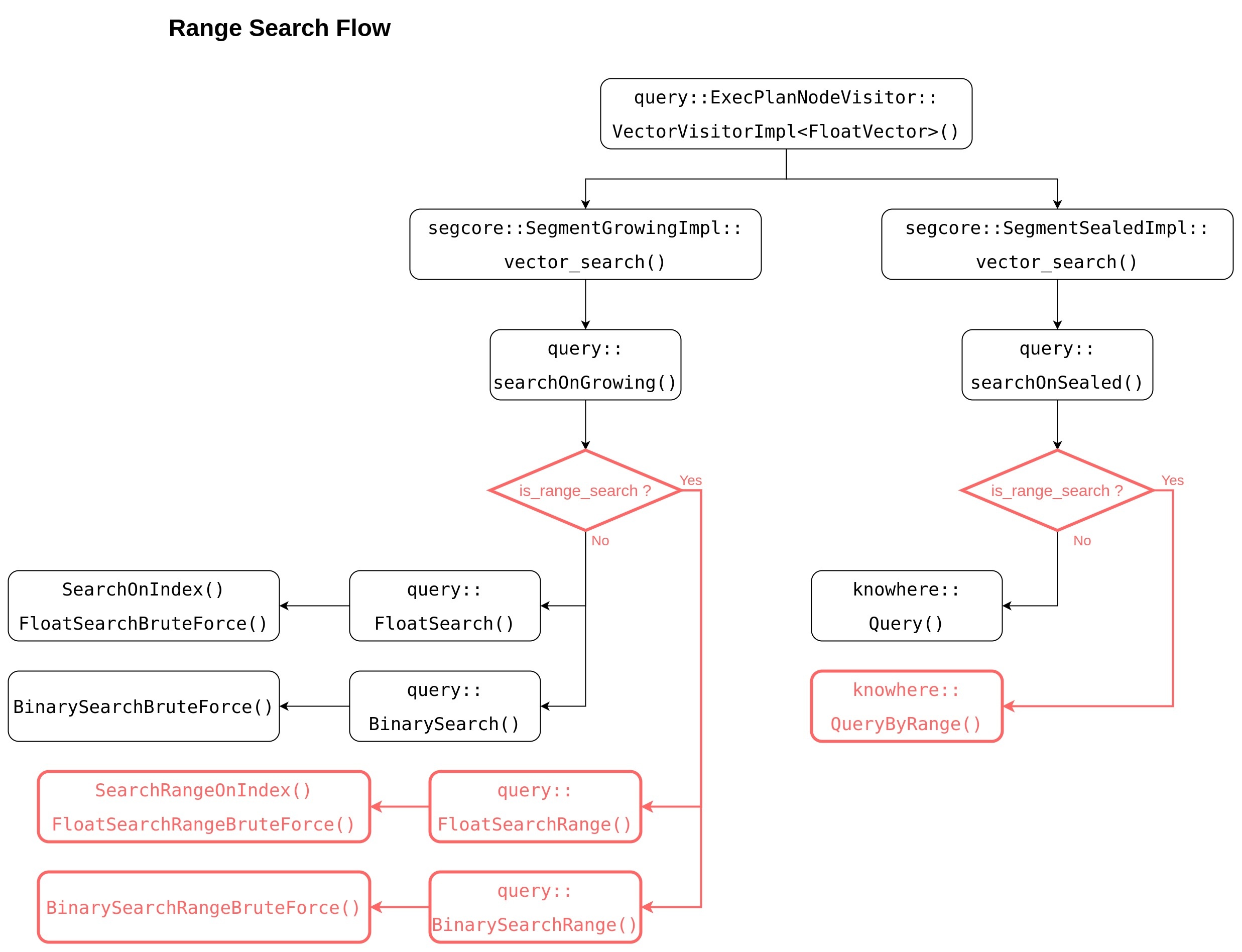Current state: ["Under Discussion"]
ISSUE: #17599
PRs:
Keywords: range search, radius, query
Released:
Summary(required)
At present, the behavior of Query() in Milvus is to return TOPK most similar results for each vector to be queried.
The purpose of this MEP is to realize another query function. The user specifies a query "radius", and Milvus queries and returns all results with distance better than this "radius" ("< radius" for "L2"; "> radius" for "IP")
This function can be considered as a "superset" of the existing query function, because if you sort the results of range search and take the first `topk` results, they will be identical with the return result of the existing query function.
The result output of this MEP is different from the original query result. The original query result is with fixed length `nq * topk`, while the return result of range search is variable length. In addition to `IDs` / `distances`, `lims` is also returned to record the offset of the query result of each vector in the result set. Another MEP pagination will uniformly process the results of `Query` and `QueryByRange` and return them to the client, so the processing of the returned results is not within the scope of this MEP discussion.
Motivation(required)
A user (developing recommendation system) asked for Milvus to realize the function of querying by distance, that is, to return all results whose similarity is better than a certain "radius".
Public Interfaces(optional)
- No interface change in Milvus and all SDKs
We reuse the interface `Query()` to realize the function of range search, so the interface of Milvus and all SDKs need not to be changed. We only need add "radius" information to params. When "radius" is specified, the "limit" setting is ignored.
As shown in the following figure, set "radius: 888" in search_ params.params.
default_index = {"index_type": "HNSW", "params":{"M": 48, "efConstruction": 500}, "metric_type": "L2"}
collection.create_index("float_vector", default_index)
collection.load()
search_params = {"metric_type": "L2", "params": {"ef": 32, "radius": 888}}
res = collection.search(vectors[:nq], "float_vector", search_params, limit, "int64 >= 0")
- Need add new interface `QueryByRange()` in knowhere
virtual DatasetPtr QueryByRange(const DatasetPtr& dataset, const Config& config, const faiss::BitsetView bitset);
There is one proposal that not to add new interface QueryByRange(), but reusing interface Query() for range search. Considering the implementation in Knowhere, we don't accept this proposal, because not all types of index support range search.
By now, Knowhere can support 13 types of index, but only 8 of them can support range search (the cell filled with BLUE):
| BinaryIDMAP | BinaryIVF | |||
| IDMAP | IVF_FLAT | IVF_FLAT_NM | IVF_SQ | IVF_PQ |
| HNSW | ANNOY | |||
| RHNSW_FLAT | RHNSW_IVF | RHNSW_SQ | RHNSW_PQ |
Design Details(required)
Describe the new thing you want to do in appropriate detail. This may be fairly extensive and have large subsections of its own. Or it may be a few sentences. Use judgment based on the scope of the change.
下图为一个 Search 请求从 SDK 到 SEGCORE 的完整调用栈,range search 完全复用该调用栈,不需要做任何改动。range search 只需要将参数 "radius" 在 SDK 端放入查询参数 "param" 中。
下图为 SEGCORE 内部向量查询时的调用栈示意图,黑色部分为现已实现的功能。
对于 sealed segment,要实现 range search 功能需要 knowhere 提供 QueryByRange 功能;
对于 growing segment 时,由于没有创建 index ,所以无法用 knowhere IDMAP 实现的暴搜功能,只能自己额外实现了暴搜的全套逻辑。若要实现 range search,需要另外实现红色部分所示的功能函数。
另一解决方案是,knowhere 提供一种新的 IDMAP 索引,该索引不需要插入向量数据,只需要指定向量数据的外部内存地址。growing segment 在查询时可临时生成该种索引,继而调用 IDMAP 提供的 Query & QueryByRange 接口,该索引在用完后也即刻销毁。此方案没有额外的内存开销,但是否可行需进一步调研。
查询结果的处理
Query 返回的查询结果有2种,一种为 SubSearchResult,用于存放 segment 中每个 chunk 的查询结果。
需要添加成员变量 "is_range_search_" 和 "lims_",以及成员函数 "merge_range()" 和 "merge_range_impl()"。
class SubSearchResult {
... ...
static SubSearchResult
merge(const SubSearchResult& left, const SubSearchResult& right);
void
merge(const SubSearchResult& sub_result);
static SubSearchResult
merge_range(const SubSearchResult& left, const SubSearchResult& right); // <==== new added
void
merge_range(const SubSearchResult& sub_result); // <==== new added
private:
template <bool is_desc>
void
merge_impl(const SubSearchResult& sub_result);
void
merge_range_impl(const SubSearchResult& sub_result); // <==== new added
private:
bool is_range_search_; // <==== new added
int64_t num_queries_;
int64_t topk_;
int64_t round_decimal_;
MetricType metric_type_;
std::vector<int64_t> seg_offsets_;
std::vector<float> distances_;
std::vector<size_t> lims_; // <==== new added
另一种为 SearchResult,用于存放该 segment 的查询结果。
需要添加成员变量 "is_range_search_" 和 "lims_"。
struct SearchResult {
... ...
public:
int64_t total_nq_;
int64_t unity_topK_;
void* segment_;
// first fill data during search, and then update data after reducing search results
bool is_range_search_; // <==== new added
std::vector<float> distances_;
std::vector<int64_t> seg_offsets_;
std::vector<size_t> lims_; // <==== new added
... ...
};
在 Query node 中还需要实现多个 segment 之间的 reduce_range();
在 Proxy 中还需要实现多个 SearchResult 之间的 reduce_range();
关于输出结果的处理,需要和 Pagination 的具体实现方案一起讨论。
Compatibility, Deprecation, and Migration Plan(optional)
- What impact (if any) will there be on existing users?
- If we are changing behaviors how will we phase out the older behavior?
- If we need special migration tools, describe them here.
- When will we remove the existing behavior?
Test Plan(required)
Describe in a few sentences how the MEP will be tested. We are mostly interested in system tests (since unit tests are specific to implementation details). How will we know that the implementation works as expected? How will we know nothing broke?
已为 range search 生成了基准测试数据集 sift-128-eucliean-range.hdf5 和 sift-4096-hamming-range.hdf5
Rejected Alternatives(optional)
If there are alternative ways of accomplishing the same thing, what were they? The purpose of this section is to motivate why the design is the way it is and not some other ways.
References(optional)
Briefly list all references

